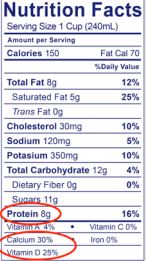Dairy in Your Child's Diet

For many people, a healthy and well-balanced diet includes foods from all the food groups. The dairy group is especially important for children and youth because of the high amounts of protein, calcium, and vitamin D that are used to build strong bones and reduce the risk of chronic diseases later in life (Thorning et al., 2016). This fact sheet will present the health benefits of dairy and bust some common myths to assist you in making informed decisions when purchasing dairy products for your children. This fact sheet also includes information on dairy alternatives for children who, for one reason or another, do not consume dairy products.
What Are the Health Benefits of Dairy Products?
- Children who are exposed to highly allergenic foods (milk, peanuts, eggs, wheat, etc.) earlier in life have a lower risk of developing a food allergy (Chin, Chan, & Goldman, 2014; American Academy of Pediatrics [AAP], 2013).
- Children build 40% of their bone mass between the ages of 9-14 and 90% of their bone mass by their late teens. Dairy products contain all of the crucial vitamins and minerals used for this process in one small package (Ryan, 2017). Specific nutrients and benefits are listed in Table 1.
- A variety of milk products, such as yogurt, often contain probiotics. These microorganisms may contribute to a variety of health benefits, although more research needs to be done in this area (Brown-Riggs, 2014; Fernández, Hudson, Korpela, de los Reyes-Gavilán, 2015).
- Dairy products have characteristics that protect the enamel of children’s teeth, creating stronger teeth and a healthier mouth (Abd-elmonsif, El-Zainy, Abd-elhamid, 2017).
- Milk provides higher amounts of protein, calcium, and potassium per calorie than any other commonly consumed food (Rozenberg et al., 2015). For example, for a child 4-8 years of age, an 8oz glass of milk provides 40% of their daily protein needs, 50-60% of their daily calcium needs, and 10% of their daily potassium needs (United States Department of Agriculture [USDA], n.d.; USDA, n.d.)
Table 1. Benefits of Key Nutrients Found in Milk
| Nutrient | Benefits |
|---|---|
| Protein | Protein aids in strong bone development, along with muscle and tissue repair. |
| Calcium | Calcium is a key mineral in developing healthy bones. It also likely protects against cancer, diabetes, and high blood pressure. |
| Potassium | Along with aiding in bone health, potassium is essential for a healthy heart. |
| Zinc | Zinc aids in immune function. |
| Phosphorus | Phosphorus aids in the upkeep of strong bones and boosts enamel and tooth health. |
| Vitamin D | Vitamin D promotes calcium absorption in the intestines and aids in bone growth. |
Dairy Myth Busters

Myth: Dairy is harmful to my child’s health.
Fact: Dairy is power packed with essential vitamins and minerals that will help your child build strong bones and prevent some bone-related diseases. Consumption of dairy products does not appear to be associated with heart diseases (Yu & Hu, 2012). In fact, some studies have found that consuming dairy may protect against chronic diseases such as type II diabetes, certain cancers, and hypertension (Erikson et al., 2015; Thorning et al., 2016). However, children who are lactose intolerant or allergic to milk and other dairy products, should consume dairy alternatives for optimal health and safety. Table 2 includes a list of milk alternatives and how their nutrient amounts compare to cow’s milk.
Myth: Organic milk is healthier than regular milk.
Fact: In order to be labeled “organic” cow’s milk must come from dairy cow’s that: 1) are not treated with antibiotics, 2) are not treated with hormones, 3) have access to an organic-certified pasture for grazing, 4) are fed only 100% organic feed, and 5) live in conditions that support the health and natural behaviors of cows (USDA, n.d.). With that said, there is no difference in the nutritional content of the nine key nutrients (protein, calcium, vitamin D, vitamin A, potassium, phosphorus, vitamin B12, riboflavin, and niacin),found in both organic and regular cow’s milk (Magkos, Arvaniti, & Zampelas, 2003). As a result, regular and organic milk are both nutritious and healthy beverage options for your children. Select the milk that fits in your food budget and supports your personal values.
Myth: Waiting to expose my child to dairy products will decrease their chance of a milk allergy.
Fact: Exposing children to highly allergenic foods earlier in life has actually been shown to help prevent food allergies (Chin, 2014). Introduction of dairy products is recommended around 6 months of age when a baby starts eating solid foods (Fleischer, 2013). If your infant has asthma, eczema or a family history of food allergies, consult your pediatrician before offering your infant highly allergenic foods such as dairy products (Chin, 2014). Also keep in mind, the American Academy of Pediatrics recommends waiting until the child is one year of age before serving them cow’s milk to drink. Up until age one, breast milk and infant formula are the best fluids parents can offer (Martin, Ling, & Blackburn, 2016). From 1-2 years of age, most children should drink whole cow’s milk instead of lower fat options unless they have a family health history that may suggest a need for a lower fat option (Fleischer Michaelsen, Hoppe, Lauritzen, & Molgaard, 2007).
Myth: Raw milk that is unpasteurized is healthier.
Fact: Milk or milk products that have not been pasteurized are considered raw. The process of modern pasteurization includes increasing the temperature of milk to at least 161° F, followed by rapid cooling. This pasteurization process eliminates harmful bacteria and does not alter or eliminate any nutrient values within dairy products (AAP, 2014). The American Academy of Pediatrics strongly encourages the consumption of pasteurized milk since the risk of foodborne illness is much lower (AAP, 2014). This is an important consideration especially for pregnant women, infants, and children (Maldonado, Glode, & Bhatia, 2014).
Myth: Dark leafy greens will provide my child with just as much calcium as a glass of milk.
Fact: It is true that dark leafy vegetables contain high amounts of calcium, however the calcium is not absorbed as well in the body as calcium from dairy. As a result, it can be hard for children to consume enough dark leafy greens to meet their calcium needs. For example, a child would have to eat 16 cups of spinach in one day to match the amount of available calcium in one glass of milk (Rozenberg, 2015).
Factors to Consider When Selecting Common Milk Alternatives
Many children do not consume dairy products for medical, health, religious, or personal reasons. There are many alternative types of milk available on the market, see the table 2 below for some more commonly available types. However, it is likely you will find many more types on your supermarket shelves. When shopping for alternative milk products keep in mind they are all different in the amount of key nutrients they contain. Check the nutrition facts label and choose a type of milk product with as much calcium and vitamin D as cow’s milk. If possible, choose one with just as much protein as cow’s milk as well. As with cow’s milk, be aware that flavored versions (chocolate, vanilla, etc.) can be high in sugar. The image to the right provides an example of where an individual can look on a nutrition facts label, to find information on the content of the protein, calcium, and vitamin D within the product of their choice. This is a quick and easy way to make sure your child is getting the desired nutrients!
*This nutrition facts label is for 1 cup of whole milk and may slightly vary depending on the brand.
| Milk | Taste | Substitutions | Nutrient Comparison |
|---|---|---|---|
| Lactose free cow’s milk |
|
|
|
| Almond Milk |
|
|
|
| Soy Milk |
|
|
|
| Rice Milk |
|
|
|
Four Fun Ways to Incorporate Dairy

The USDA’s Dietary Guidelines has different dairy recommendations for children of various age groups (USDA, 2017). For example, it is recommended that each day, 2-3 year olds consume 2 cups, 4-8 year olds consume 2 ½ cups, and 9-18 year olds consume 3 cups of dairy products. Here are some ways to help your child get enough dairy in their diet.
- Add low-fat cheese sticks to your child’s lunch is a quick and easy way to incorporate more dairy into their day.
- Freeze small dollops of a yogurt and fruit mixture to make delicious yogurt bites for another easy way for your child to get more dairy! Yogurt bites are a healthier alternative to popsicles and will be great for the hot summer months.
- Yogurt parfaits in the morning will keep your kiddos tummy full until snack time. These beautiful creations can be layered in a clear plastic cup and have an added bonus of yummy fruit and whole grain granola. Quick sample recipe: layer a cup or bowl in the following order from bottom to top; berries or fruit of choice, yogurt of choice, top with granola or cereal! Other toppings can include, but are not limited to: coconut, sliced nuts, chia seeds, and fresh fruit.
- Try cottage cheese and crackers as a speedy snack. This protein-packed snack will be sure to keep them full until dinnertime. As an added bonus, try whole grain crackers to fuel their afternoon adventures!
Dairy products such as milk, yogurt, and cheese can be an important part of a wellbalanced diet for children. Dairy products are rich in important nutrients such as protein, calcium, and vitamin D. Admittedly, there are valid circumstances when children, for various reasons, do not consume dairy products. It is important to know what alternative products are available for these children to make sure they are still meeting their nutritional needs during each stage of rapid growth and development.
References
- Abd-elmonsif, N. M., El-Zainy, M. A., Abd-elhamid, M. M. (2017). Comparative study of the possible effect of bovine and some plant-based milk on cola-induced enamel erosion on extracted human mandibular first premolar (scanning electron microscope and X-ray microanalysis evaluation. Future Dental Journal, 3(1), 22-27. doi: https://doi.org/10.1016/j.fdj.2017.02.001.
- Bridges, M. (2018). Moo-eve over cow’s milk: The rise of plan-based diary alternatives. Nutrition Issues in Gastroenterology, 171. Retrieved from https://med.virginia.edu/ginutrition/wpcontent/uploads/sites/199/2014/06/January-18-MilkAlternatives.pdf
- Brown-Riggs, C. (2014). The gut microbiota-is it a novel contributor to the obesity and diabetes epidemics? Today’s Dietitian, 16(11), 22. Retrieved from http://www.todaysdietitian.com/newarchives/111114p22.sht ml.
- Chin, B., Chan, E. S., Goldman, R. D. (2014). Early exposure to food and food allergy in children. Canadian Family Physician, 60(4), 338-339. Retrieved from https://www.ncbi.nlm.nih.gov/pmc/articles/PMC4046529/.
- Ericson, U., Hellstrand, S., Brunkwall, L., Schulz, C. A., Sonestedt, E., Wallström, P., Orho-Melander, M. (2015). Food sources of fat may clarify the inconsistent role of dietary fat intake for incidence of type 2 diabetes. American Journal Clinical Nutrition, 101(5),1065-1080. doi: 10.3945/ajcn.114. 103010.
- Fernández, M., Hudson, J., Korpela, R., de los ReyesGavilán, C. G. (2015). Impact on human health of microorganisms present in fermented dairy products: an overview. Biomed Research International. doi: 10.1155/2015/412714.
- Fleischer, D. A. (2013). Early introduction of allergenic foods may prevent food allergy in children. American Academy of Pediatrics News, 34(2), 13. doi: 10.1542/aapnews.2013342- 13 Reports, 20(24). doi.org/10.1007/s11883-018-0724-z
- Fleischer Michaelsen, K., Hoppe, C., Lauritzen, L., & Molgaard, C. (2007) Whole cow’s milk: Why, What, and When. Issues in Complementary Feeding, 60, 201-219.
- Maldonado, Y., Glode, M., Bhatia, J. (2014). Consumption of raw or unpasteurized milk and milk products by pregnant women and children. American Academy of Pediatrics, 133(1),175-179. doi: 10.1542/peds,2013-3502.
- Magkos, F, Arvaniti, F & Zampelas, A. (2003). Organic food: nutritious food or food for thought? A review of the evidence. International. Journal of Food Sciences and Nutrition, 54(5), 357–71. doi.org/10.1080/09637480120092071
- Martin, C., Ling, P., & Blackburn, G. (2016). Review of infant feeding: Key features of breast milk and infant formula. Nutrients, 8(5), 279. doi:10.3390/nu8050279
- Rozenberg, S., Body, J.J., Bruyere, O., Bergmann, P., Brandi M. L., Cooper, C, Reginster, J. Y. (2015). Effects of dairy products consumption on health: Benefits and beliefsA commentary from the Belgian Bone Club and the European Society for clinical and economic aspects of osteoporosis, osteoarthritis and musculoskeletal diseases. Calcified Tissue International, 98, 1-17. doi: 10.1007/s00223-015-0062-x.
- Ryan, M. (2017). Now is the time to build your child’s bone “bank account.” Retrieved from: https://www.eatright.org/health/wellness/preventingillness/now-is-the-time-to-build-your-childs-bone-bankaccount.
- Thorning, T. K., Raben, A., Tholstrup, T., Soedamah-Muthu, S. S., Givens, I., Astrup, A. (2016). Milk and dairy products: Good or bad for human health? An assessment of the totality of scientific evidence. Food & Nutrition research, 60. https://doi.org/10.3402/fnr.v60.32527.
- United States Department of Agriculture (n.d.). Guidelines for organic certification of dairy livestock. Retrieved from https://www.ams.usda.gov/sites/default/files/media/Dairy%2 0-%20Guidelines.pdf
- United States Department of Agriculture. (2017). All about the dairy group. Retrieved from https://www.choosemyplate.gov/dairy United States Department of Agriculture. (2017). Nutrients and health benefits. Retrieved from https://www.choosemyplate.gov/dairy-nutrients-health
- United States Department of Agriculture. (n.d.). Dietary reference intakes: macronutrients. Retrieved from http://www.nationalacademies.org/hmd/~/media/Files/Activit y%20Files/Nutrition/DRITables/8_Macronutrient%20Summary.pdf?la=en
- United States Department of Agriculture. (n.d.). Dietary references intakes (DRIs): recommended dietary allowances and adequate intakes, vitamins. Retrieved from http://www.nationalac ademies.org/hmd/~/media/Files/Activity%20Files/Nutrition/D RI-Tables/2_%20RDA%2 0and%20AI%20Values_Vitamin%20and%20Elements.pdf?l a=en.
- Yu, E., & Hu, F. (2018). Dairy products, dairy fatty acids, and the prevention of cardiometabolic disease: A review of recent evidence. Current Atherosclerosis
Authors
Richelle Hudson Dietetics Student; Mateja R. Savoie Roskos PhD, MPH, RD; Carrie Durward PhD, RD
Related Nutrition Articles








